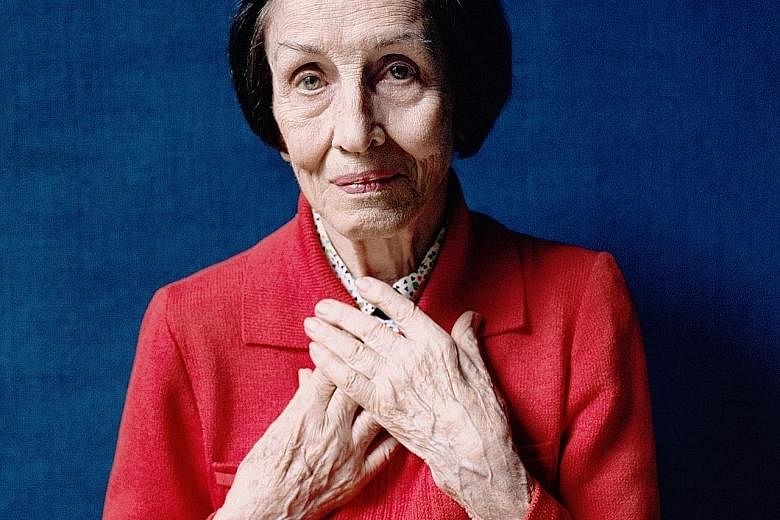NEW YORK • The 96-year-old French painter and author Francoise Gilot - famously known as the former lover and muse to artist Pablo Picasso, and the mother of two of his children, Claude and Paloma - has a book of sketches out last week that she completed during her travels to India, Senegal and Venice between 1974 and 1981.
While most artists use sketchbooks to harness their impressions into material for their work - to help them remember - Gilot has used hers to forget.
"Things I have seen, I want to take them out of my mind," she said in her brightly lit living room on Manhattan's Upper West Side. Her home doubles as a studio in which she paints nearly every day. Canvases are hung on the two-storey-high walls, stacked on the floor and displayed on easels.
"Art doesn't come from what is around you, but from what is inside of you."
This philosophical approach is unmistakable in the new monograph (published by Taschen), Francoise Gilot: Three Travel Sketchbooks, which includes drawings and watercolours that bear little stylistic resemblance to her public work. Instead, they offer an intimate glimpse into Gilot's inner life.
When asked about her years with Picasso and the comparisons that have been made between their work, she replied with a sly grin: "Sometimes you need an umbrella when it rains."
But Gilot has hardly lived her life under the shelter of that umbrella. Dorothea Elkon, her New York gallery owner and longtime friend, stressed Gilot's fierce independence.
While the legacy of her relationship with Picasso has endured as an undeniable presence in her life (Paloma Picasso called it a "nuisance" to her mother), Gilot has worked hard to maintain her autonomous presence in the art world.
"It's a dedication that's essential in her life," said Paloma, who vividly recalls being a child, sitting on the balcony outside her mother's studio and watching her paint for hours.
Gilot was born in a suburb of Paris in 1921. Her mother was an artist, and her father, an agronomist, insisted that his daughter pursue a law degree after she graduated from the Sorbonne in 1938 with a bachelor's in philosophy.
But while enrolled in law school, Gilot studied art in her free time - entering into the tutelage of Hungarian painter Endre Rozsda, who would become a lifelong mentor and friend - and she eventually abandoned the legal track.
She met Picasso at Le Catalan Restaurant in Paris, in 1943. She was 21; he was 61.
During their roughly 10 years together (a period described at length in her best-selling 1964 memoir, Life With Picasso), Gilot mingled in a group that included Henri Matisse and Georges Braque, though today she claims her art is not influenced by anyone.
"I don't believe in influences," she said. (Picasso's biographer John Richardson agreed: "Picasso took from her rather more than she took from him.")
By autumn 1953, Gilot had ended the relationship. Picasso was displeased; after all, she was allegedly the only woman ever to have left him. He ran her out of town and turned the Paris art world against her, Elkon said.
In 1955, she married French artist Luc Simon. Their marriage lasted only a few years and produced a daughter, Aurelia. In 1970, Gilot married virologist Jonas Salk; they were together until his death in 1995.
The sketches in this latest book are a stylistic departure from her body of work, and she considers them deliberately unfinished, completed as they were in notebooks she kept while travelling with Salk when he was collecting research for the polio vaccine he would go on to develop.
They contain watercolour drawings but also words, written in careful, beautiful script. For Gilot, colours, text and shapes are used interchangeably - synesthetically.
"If you can think of something in words, then you can see it in images too," she said.
Narrative has always been paramount to Gilot. The floor-to-ceiling bookshelves that line the walls of her apartment, which is just down the block from the Hotel des Artistes, are a testament to her literary mind.
Visual monographs on Claude Monet, Francis Bacon and, yes, Picasso are shelved alongside volumes of T.S. Eliot, Shakespeare and Evelyn Waugh.
She has published collections of her own verse, and even these sketchbooks contain full pages devoted solely to her handwritten text.
"I was always good with poetry and letters," she said.
Gilot's friend, actor and playwright Therese Cremieux, who interviewed her for the pamphlet that is included in Three Travel Sketchbooks, is the one who convinced her to publish this book. Gilot was hesitant.
"Francoise said, 'No, it's not going to interest anyone,'" said Cremieux, who argued that readers would like to see what Gilot calls "the process".
Completed mostly on tiny, bumpy plane rides between remote corners of the world after she had taken time to reflect on the moments she had encountered, the sketches favour figures over scenes: "A landscape is always there and the people are not," Gilot said.
"You can call it a diary," she added. "What I draw has meaning. In my mind, I notice what I feel, and not what is there."
Aurelia Simon - who, in addition to being her daughter, is also Gilot's archivist - noted that if you look through her body of work, "you can see all of the people in her life coming through, all of the friends, the men in her life, the children growing up, the places she went. You can really feel the emotion she is going through and how she reacts, and what catches her eye or memory".
NYTIMES

